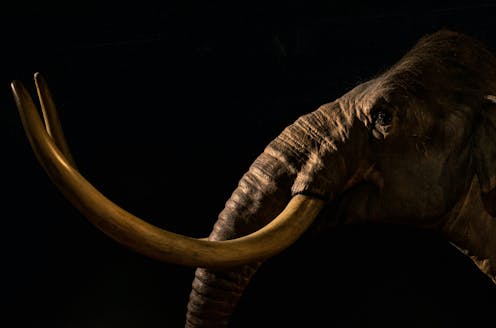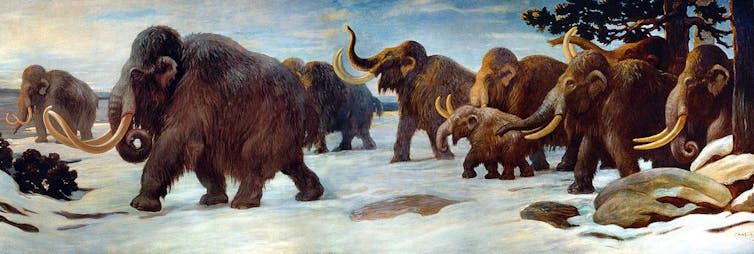
In just the last several months, de-extinction — bringing back extinct species by recreating them or organisms that resemble them — has moved closer from science fiction to science fact. Colossal Biosciences — an American for-profit de-extinction startup headed by geneticists George Church and Beth Shapiro — announced two major achievements almost back-to-back.
In the first, scientists spliced part of the woolly mammoth’s genome into mice to create “woolly mice,” incredibly cute pom-pom like rodents sporting coats that express the genes of long-extinct woolly mammoths.
Just a few weeks later, Colossal announced an even bigger achievement, claiming to have brought back the dire wolf, a contemporary of the woolly mammoth who, like their Ice Age proboscidean co-travellers, last roamed the Earth roughly 10,000 years ago.
Read more: Colossal Bioscience's attempt to de-extinct the dire wolf is a dangerously deceptive publicity stunt
Mammoth popularity
Woolly mammoths are at the forefront of these controversial de-extinction efforts. Despite a deep bench of more recently extinct species — the dodo, the moa, passenger pigeons, the bucardo, quagga, thylacine, aurochs and a whole host of others — readily available to take centre stage in de-extinction efforts, woolly mammoths figure prominently in de-extinction stories, both scientific and popular.
Woolly mammoths featured prominently in the imagery of Revive & Restore, a “genetic rescue” conglomerate of scientists and futurists headed by tech-guru Steward Brand; in 2021, Colossal “established ownership” over woolly mammoth revival. Colossal’s own logo visualizes CRISP-R, the gene-splicing technology that facilitates de-extinction, and the signature spiralled tusks of Mammuthus primigenius.
In popular culture, woolly mammoths have been a source of fascination for the last several centuries. Thomas Jefferson famously held out hope that live mammoths would be found beyond the frontier of American colonialism in the late-1700s, while early excavations of American mastodons were major events in the early 1800s. American painter Charles Willson Peale captured the first such excavation in oils, and later capitalized on that mastadon’s skeleton in his Philadelphia museum.
More recently, Manny the mammoth featured in the ongoing Ice Age animated film franchise, first launched in 2002.
Climate icons
At the same time, woolly mammoths have also become an emblem of the contemporary climate crisis. During the recent wave of defacing famous artwork in order to draw attention to the climate crisis, environmental activists painted the (fortunately artificial) tusks of the Royal B.C. Museum’s woolly mammoth model bright pink.
In a 2023 publicity stunt, the Australian cultured-meat startup, Vow, unveiled a mammoth meatball produced out of the woolly mammoth’s genome with sheep DNA as filler. Not for sale, the mammoth meatball was scorched before an audience at the Dutch science museum, Nemo.
The stunt was intended to call attention, again, to the plight of the Earth’s climate, the unsustainability of industrialized food systems and the potential for lab-grown meat to square this particular circle.
Model animals
For a creature that no human being has ever seen live and in the flesh, woolly mammoths certainly get a lot of media exposure. How did this long-extinct species become the emblem of contemporary extinction and de-extinction?
People have been interacting with the remains of woolly mammoths for hundreds of years. Dig a hole deep enough almost anywhere in the northern hemisphere, and you are apt to come across the bones or maybe the tusks of extinct mammoths or mastodons.
In early modern Europe, mammoth fossils were famously interpreted as the bones of unicorns and giants before being recognized as belonging to elephant-like creatures around 1700. Only around 1800 were mammoths recognized as a distinct and extinct species of proboscidea.
Elsewhere in Arctic regions, especially Siberia, Indigenous Peoples were familiar with mammoth remains preserved by permafrost. As rivers and their tributaries surged during annual thaws, whole carcasses of mammoths (and woolly rhinos) were sometimes exposed.
Local peoples who came across these remains, apparently recently dead but belonging to creatures they never saw walking the Earth’s surface, surmised that they were great burrowing rodent-like animals that tunnelled through the ground and perished if they accidentally came into contact with atmosphere.
Read more: Ancient DNA suggests woolly mammoths roamed the Earth more recently than previously thought
Around the Arctic, including in Alaska, permafrost prevented the fossilization of mammoth tusks as well as bodies, and this ice ivory was — and remains — an important element of Arctic economies, carved locally and exchanged into historically regional, and now global, markets.
Continued relevance
Despite their association with the distant past, woolly mammoths have long resonated with modern human cultures as their fossilized or preserved body parts entered economic practices and knowledge systems alike. But as the extinction of once numerous species like the passenger pigeon, the American bison and African elephant began to loom over the late 19th century, woolly mammoths took on new meanings in the context of modern extinction and emergent understandings of human evolution.

Revolutions in geology, archeology, paleontology and related disciplines were changing long-held assumptions about the origin of humankind.
Narratives of the rise of “man the hunter” arose in natural history institutions such as the American Museum of Natural History and the Field Museum in Chicago. These origin stories were explicitly connected to the presumed extinction of woolly mammoths and their evolutionary relatives, the mastodons.
These led to some of the most powerful expressions of mammoths in visual form, like the frescoes and paintings produced by renowned paleoartist Charles R. Knight.
At the same time, cave paintings in France, Spain and elsewhere came to light in the early 20th century. For example, the 40,000-year-old frescoes at Rouffignac, France clearly depicting woolly mammoths were interpreted as further evidence of this deep and powerful historical connection.
It is this connection — the association of the rise of modern humankind with the decline and extinction of the woolly mammoth — that feeds today’s continued fascination. Notions of human complicity in extinction stories have long been embedded in modern scientific understandings of woolly mammoths. It is no accident that woolly mammoths are so central to de-extinction projects and climate activism alike.
Rebecca Woods received funding from the Social Sciences and Humanities Research Council of Canada.
This article was originally published on The Conversation. Read the original article.







